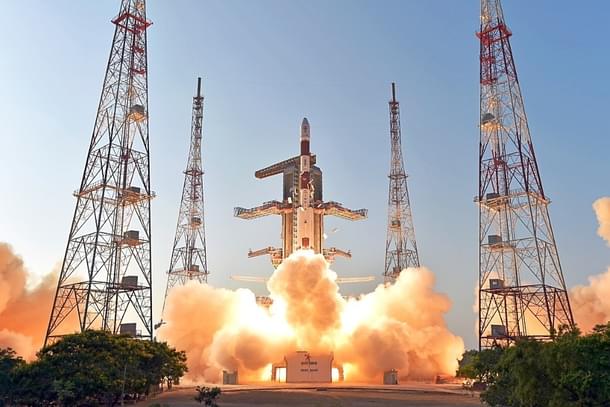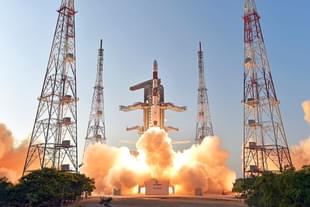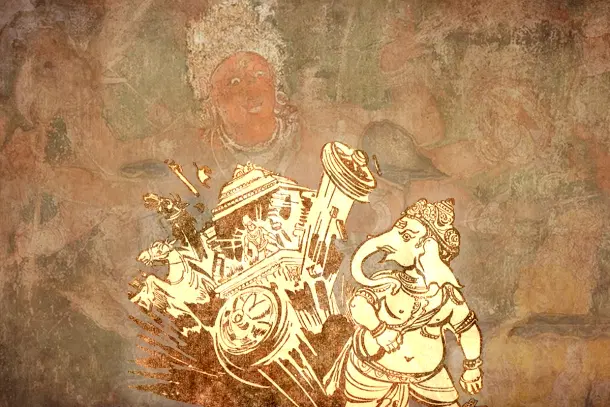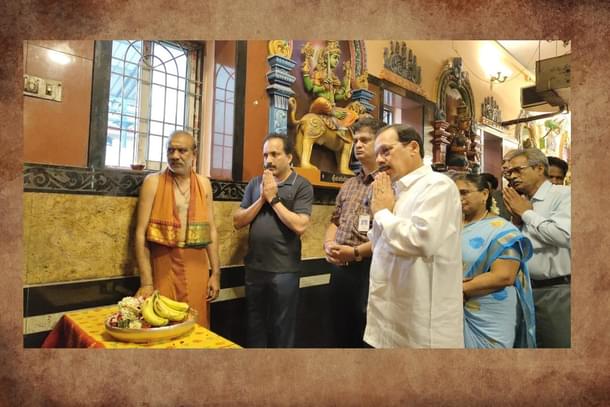Science
ISRO Scientists In Temples: The Inner Sanctum And Outer Space
Aravindan Neelakandan
Jul 15, 2023, 04:49 PM | Updated 05:41 PM IST
Save & read from anywhere!
Bookmark stories for easy access on any device or the Swarajya app.


After the emergence of social media, almost everything can become and becomes a controversy. Mainstream media, too, laps it up.
It has been a long tradition that the ISRO scientists pay such respects to the presiding Deities of that region of India from where the launches are made. Yet time and again, a few fringe voices would raise questions regarding such temple visits. Now with social media, such voices are amplified.
Then there are those who defend the temple visits by showing parallels from the West. There have been Christian priests blessing the rockets in the West etc.
There are some crucial differences between the prayers in the Western tradition to an all mighty father-figure God to oversee the launch of a space vehicle and make it successful and what the ISRO scientists are doing.
The common psychological factor in both the Western and Hindu traditions is that humans tend to turn towards the Divine when faced with a lot of uncertainty. While mathematical equations provide us certainty, various factors in space create a web of uncertainty.
While the Western prayer evokes the benevolent will of an extra-cosmic creator deity for the mission success, Hindu tradition, while using the same psychological factor, charts a different course.
In the Puranas, there is a tale of how Shiva conquers the Asuras of Tripura, embarking on a magnificent cosmic vehicle with different Devas forming its parts.
However, as Shiva entered the vehicle, its axle broke. The reason behind this incident was the failure of both the Devas and Shiva to honour Ganesha.
In Vedic Saiva literature, the Asuras of Tripura symbolise three inner impurities: egotism, karmic bondage, and delusion caused by Maya. The battle described in the story represents the endeavour to overcome these impurities through various efforts and means.
The main point emphasised here is that even a battle fought with inner righteousness can turn into an expression of ego if its divine essence is forgotten.
Paying homage to Ganesha transforms any endeavour into a sacred pilgrimage towards the Divine. Conversely, if we neglect this, it can easily become an ego-driven pursuit.

In another context Dr Ambedkar pointed out that when we serve humanity or society it is not because that is the ultimate collective as Marxist theology wants us to believe, but for the unfoldment of one's own self.
Unlike a drop of water which submerges its existence with the ocean in which it is dropped, man does not lose his identity in the society in which he lives. The man's life is independent. He is born not for the service of the society, but for the development of his self.What Path to Salvation: Dr Bhimrao Ramji Ambedkar
What is true of a social science student and activist is also true of a physical scientist - particularly the techno-scientist. They are not an automaton for the State's welfare or corporate profit. But her science should be for the unfoldment of one's own self.
The Hindu veneration of the divine before any operation - sacred or secular- is the reaffirmation of this deeper goal.
What is true of the inner spiritual space is also true of outer space.
Space missions, in fact, reveal a profound link between the realms of inner and outer exploration.
Joseph Campbell, the renowned mythologist (1904-1987), had a revelatory moment while observing NASA's moon mission and its subsequent return. It was during this observation that he realised the profound connection between these two domains:
The little module was out beyond the moon. That was a part of space that no one had ever before visited. Yet it was known to the scientists in Houston exactly how much energy to eject from those jets, when turned in just what direction, to bring the module down from outer space to within a mile of a battleship waiting for it in the Pacific Ocean. ... In other words, it then occurred to me that outer space is within us inasmuch as the laws of space are within us; outer and inner space are the same. We know, furthermore, that we have actually been born from space, since it was out of primordial space that the galaxy took form, of which our life-giving sun is a member. And this earth, of whose material we are made, is a flying satellite of that sun. We are, in fact, productions of this earth. We are, as it were, its organs. Our eyes are the eyes of this earth; our knowledge is the earth's knowledge. And the earth, as we now know, is a production of space.The inner reaches of outer space: metaphor as myth and as religion, pp.27-8
Now in India, there have always been genius seers who have explored the space within. They might belong to various traditions or Sampradayas. But these explorers of inner space always held great respect for the sacredness of their place or spot or Kshetra, where they did their Sadhana. They venerated the divine feminine of that Kshetra.
Swami Raghavendra and Sri Ramana Maharishi had different linguistic backgrounds and practised different Sampradayas in their Sadhanas. They belonged to different historical periods. Yet they both revered the Goddesses of their Kshetras: Goddess Manchalamma in the case of Sri Raghavendra Swami and Goddess Pachaiamma in the case of Sri Ramana Maharishi.
And it is Goddess Chengalamma in the case of ISRO.

Ultimately, these quests aim to unveil the vastness and enigmas of the universe, gradually illuminating us with deeper insights. They should serve as journeys of truth and the betterment of humanity rather than mere ego-driven showcases of technological competition, as witnessed in the past between the United States and the Soviet Union and as China appears to attempt now.
Hindu worship encompasses reverence for the inherent divinity within oneself and recognises the sanctity of our planet, even as we venture beyond its boundaries. It does not entail believing in an all-powerful egoistic puppeteer who would destroy a mission if not worshipped or safeguard it if pleased.
In fact, if Christian blessings on technologies incorporate this Hindu perspective, it would enhance the beauty of their tradition and align it harmoniously with science without contradiction.





